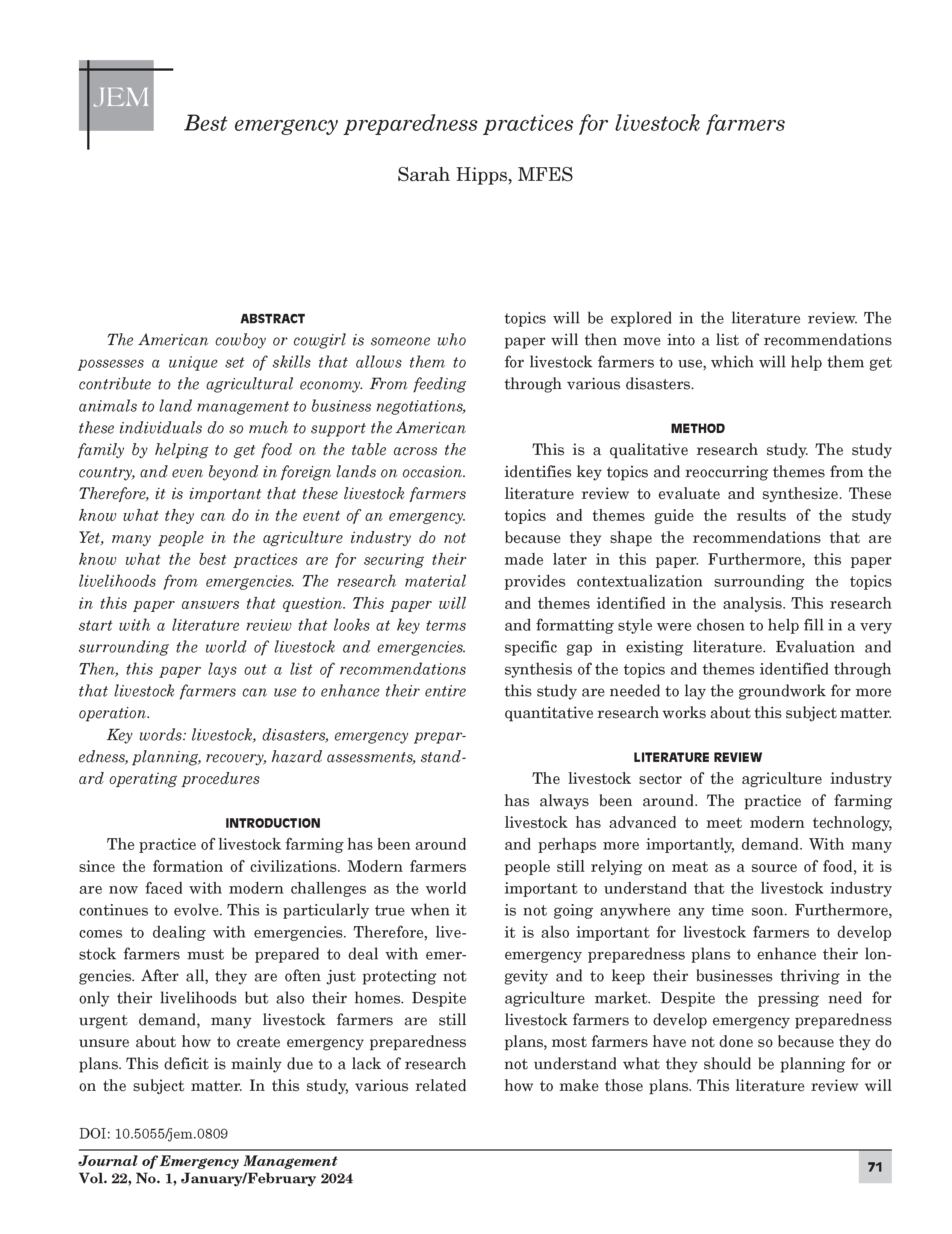Best emergency preparedness practices for livestock farmers
DOI:
https://doi.org/10.5055/jem.0809Keywords:
livestock, disasters, emergency preparedness, planning, recovery, hazard assessments, standard operating proceduresAbstract
The American cowboy or cowgirl is someone who possesses a unique set of skills that allows them to contribute to the agricultural economy. From feeding animals to land management to business negotiations, these individuals do so much to support the American family by helping to get food on the table across the country, and even beyond in foreign lands on occasion. Therefore, it is important that these livestock farmers know what they can do in the event of an emergency. Yet, many people in the agriculture industry do not know what the best practices are for securing their livelihoods from emergencies. The research material in this paper answers that question. This paper will start with a literature review that looks at key terms surrounding the world of livestock and emergencies. Then, this paper lays out a list of recommendations that livestock farmers can use to enhance their entire operation.
References
Cornell Law School: 29CFR§780.328-meaning of livestock. Legal Information Institute. Available at https://www.law.cornell.edu/cfr/text/29/780.328. Accessed September 5, 2022.
Federal Motor Carrier Safety Administration: The meaning of “Livestock” as used in the definition of “agricultural commodity”. FMCSA. Available at https://www.fmcsa.dot.gov/regulations/hoursservice/meaning-%E2%80%9Clivestock%E2%80%9D-used-definition-%E2%80%9Cagricultural-commodity%E2%80%9D. Accessed September 5, 2022.
Department of Homeland Security: Plan and prepare for disasters. Homeland Security. Available at https://www.dhs.gov/planand-prepare-disasters. Accessed September 5, 2022.
Federal Emergency Management Agency: 2020 NHS data digest: Summary results. Available at https://community.fema.gov/story/2020-NHS-Data-Digest-Summary-Results. Accessed June 12, 2023.
Department of Homeland Security: Natural disasters. Homeland Security. Available at https://www.dhs.gov/natural-disasters. Accessed September 5, 2022.
Gusner P: Natural disaster facts and statistics 2023. Forbes. Available at https://www.forbes.com/advisor/homeowners-insurance/natural-disaster-statistics/#:~:text=in%20474%20fatalities.-,Over%20the%20past%20five%20years%2C%20the%20U.S.%20has%20experienced%20an,and%20droughts%20(%24112.9%20billion). Accessed June 12, 2023.
Monroe County, Florida: Man-made disaster. Monroe County, FL—Official Website. Available at https://www.monroecounty-fl.gov/904/Man-Made-Disaster. Accessed September 5, 2022.
Centers for Disease Control and Prevention: Avian Influenza in Birds. Atlanta, GA: Centers for Disease Control and Prevention. Available at https://www.cdc.gov/flu/avianflu/avian-in-birds.htm. Accessed June 12, 2023.
Ipsos: Nearly nine in ten Americans consume meat as part of their diet. Available at https://www.ipsos.com/en-us/news-polls/nearly-nine-ten-americans-consume-meat-part-their-diet. Accessed September 5, 2022.
Statista Research Department: US consumption of eggs 2020. Statista. Available at https://www.statista.com/statistics/280958/us-households-cosnumption-of-eggs/. Accessed September 5, 2022.
Piper K: How chickens took over America’s dinner plates, in one chart. Vox. Available at https://www.vox.com/future-perfect/22287530/chicken-beef-factory-farming-plant-based-meats. Accessed September 5, 2022.
United States Department of Agriculture: AG and food sectors and the economy. USDA Ers. Available at https://www.ers.usda.gov/data-products/ag-and-food-statistics-charting-the-essentials/agand-food-sectors-and-the-economy/. Accessed September 5, 2022.
Summers K: Food price inflation is endangering global food security. American University. Available at https://www.american.edu/sis/news/20220224-food-price-inflation-is-endangering-globalfood-security.cfm. Accessed September 5, 2022.
Karim N: Disasters in Bangladesh. Nat Hazards. 1995; 11: 247-258.
Rasool S, Hamdani SA, Ayman N, et al.: The impact of natural disasters on livestock sector: A review. J Biomed Res Environ Sci. 2021; 2(8): 669-674. DOI: 10.37871/jbres1295.
Tachiiri K, Shinoda M, Klinkenberg B, et al.: Assessing Mongolian snow disaster risk using livestock and satellite data. J Arid Environ. 2008; 72(12): 2251-2263. DOI: 10.1016/j.jaridenv.2008.06.015.
Inchaisri C, Supikulpong P, Vannametee E, et al.: The effect of a catastrophic flood disaster on livestock farming in Nakhon Sawan province, Thailand. Trop Anim Health Prod. 2013; 45: 917-922. DOI: 10.1007/s11250-012-0306-y.
Chapman University: Fleeing death: Disaster evacuations in America. The Voice of Wilkinson. Available at https://blogs.chapman.edu/wilkinson/2018/10/16/fleeing-death-disaster-evacuationsin-america/. Accessed June 12, 2023.
Workers’ Safety and Compensation Commission: Hazard Assessment. Yellowknife, NT: Workers’ Safety and Compensation Commission, 2017: 1-46.
Coppola DP: Introduction to International Disaster Management. 3rd ed. Waltham, MA: Butterworth-Heinemann Inc, 2015.
Richards C, Gosz R: Livestock tagging. Oklahoma State University. Available at https://extension.okstate.edu/fact-sheets/livestock-tagging.html. Accessed November 4, 2022.
Oklahoma State University: Branding cattle: Animal welfare considerations, legal implications and alternatives. Oklahoma State University. Available at https://news.okstate.edu/articles/veterinary-medicine/2020/branding-cattle-animal-welfare-considerations-legal-implications-and-alternatives.html. Accessed November 4, 2022.
Armstrong J: Cattle vaccine basics. University of Minnesota Extension. Available at https://extension.umn.edu/beef-cow-calf/cattle-vaccine-basics#the-core-vaccinations-for-cattle-2068563. Accessed November 4, 2022.
Rodning SP, Owsley WF, Edmondson MA, et al.: Vaccinations for the beef cattle herd. Alabama Cooperative Extension System. Available at https://www.aces.edu/blog/topics/beef/vaccinations-forthe-beef-cattle-herd/. Accessed November 4, 2022.
American Family Insurance: Livestock and cattle insurance. Livestock and Cattle Insurance—American Family Insurance. Available at https://www.amfam.com/insurance/farm-ranch/coverages/livestock-cattle-insurance. Accessed October 4, 2022.
California State University, Chico: Livestock and crop integration. Center for Regenerative Agriculture and Resilient Systems. Available at https://www.csuchico.edu/regenerativeagriculture/ra101-section/integrating-livestock.shtml. Accessed June 12, 2023.
Sirmons L: The importance of wellness exams for pets: General pet health care. TexVetPets. Available at https://www.texvetpets.org/article/wellness-exams-for-pets/#:~:text=Why%20Are%20Wellness%20Exams%20Important,kidney%20disease%20can%20be%20performed. Accessed June 12, 2023.
Mohan CV, Philips MJ, Bhat BV, et al.: Farm-level plans and husbandry measures for aquatic animal disease emergencies. Rev Sci Tech. 2008; 27(1): 161-173.
Travers C, Degeling C, Rock M: Companion animals in natural disasters: A scoping review of scholarly sources. J Appl Anim Welfare Sci. 2017; 20(4): 324-343. DOI: 10.1080/10888705.2017.1322515.
Irvine L: Animals in disasters: Issues for animal liberation activism and policy. Anim Liber Philos Policy J. 2006; 4(1): 1-16.

Published
How to Cite
Issue
Section
License
Copyright 2007-2025, Weston Medical Publishing, LLC and Journal of Emergency Management. All Rights Reserved.
Leave Nobody Behind: Emergency Management in a More Inclusive Way is a trademark of Journal of Emergency Management





